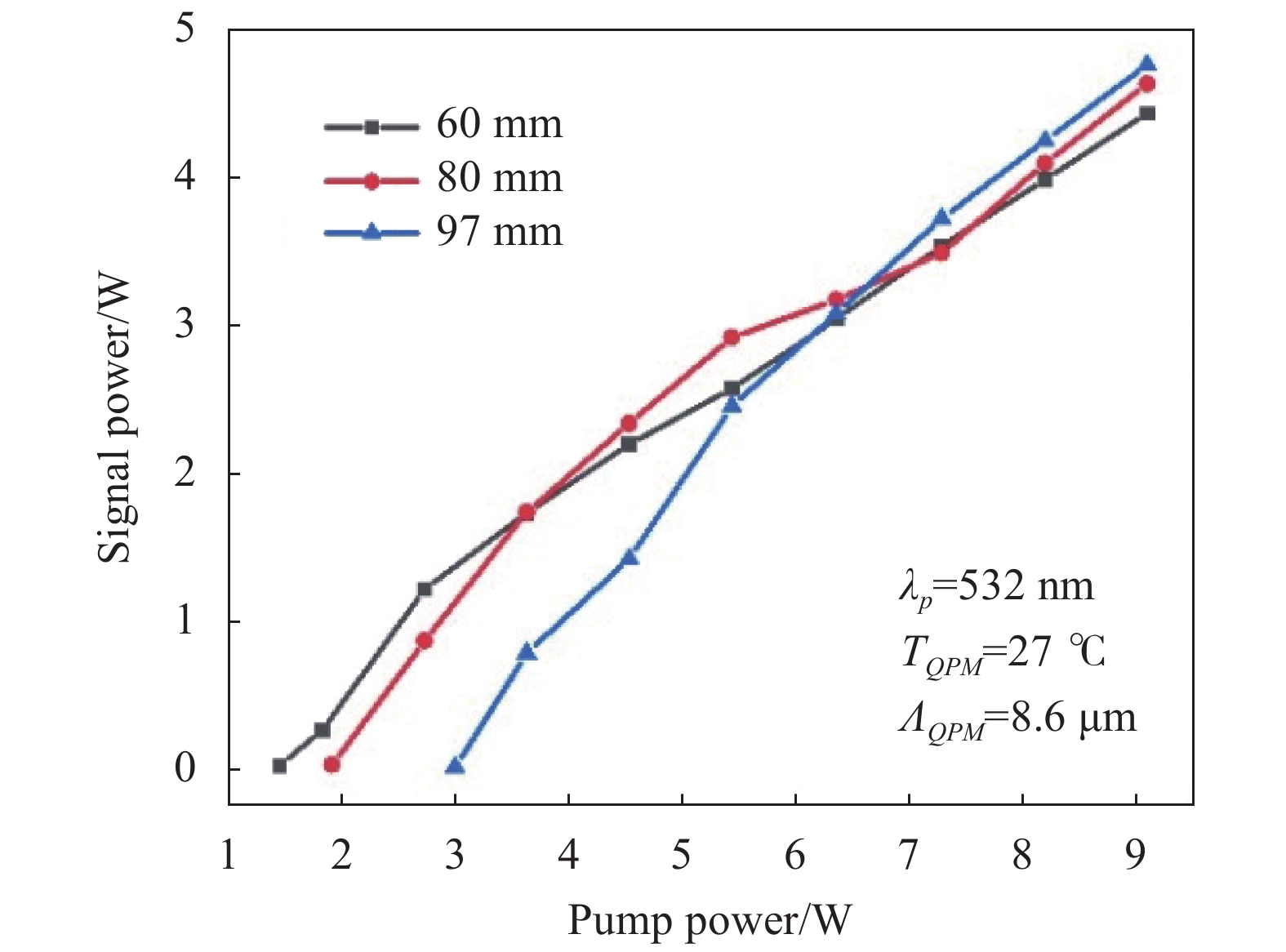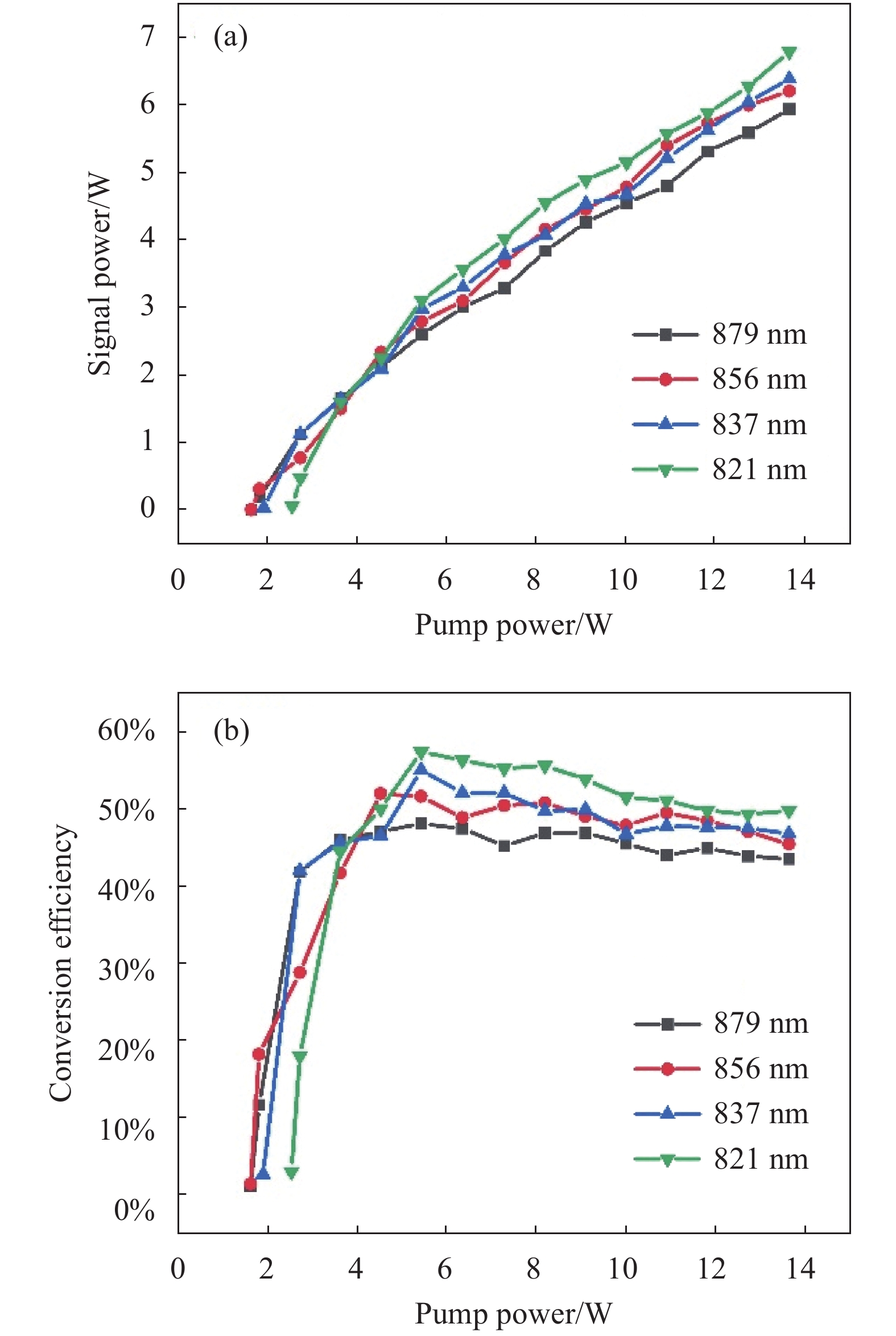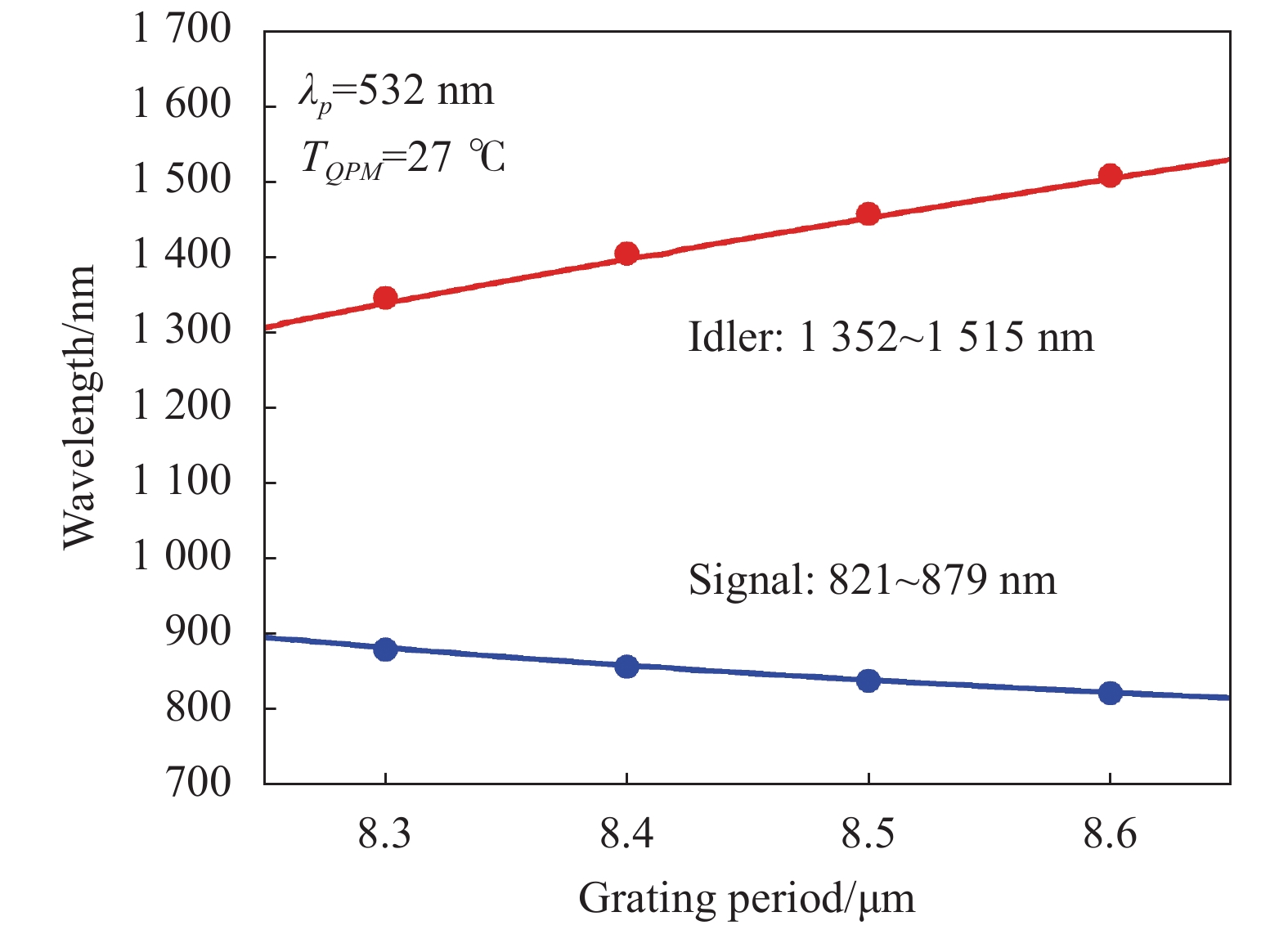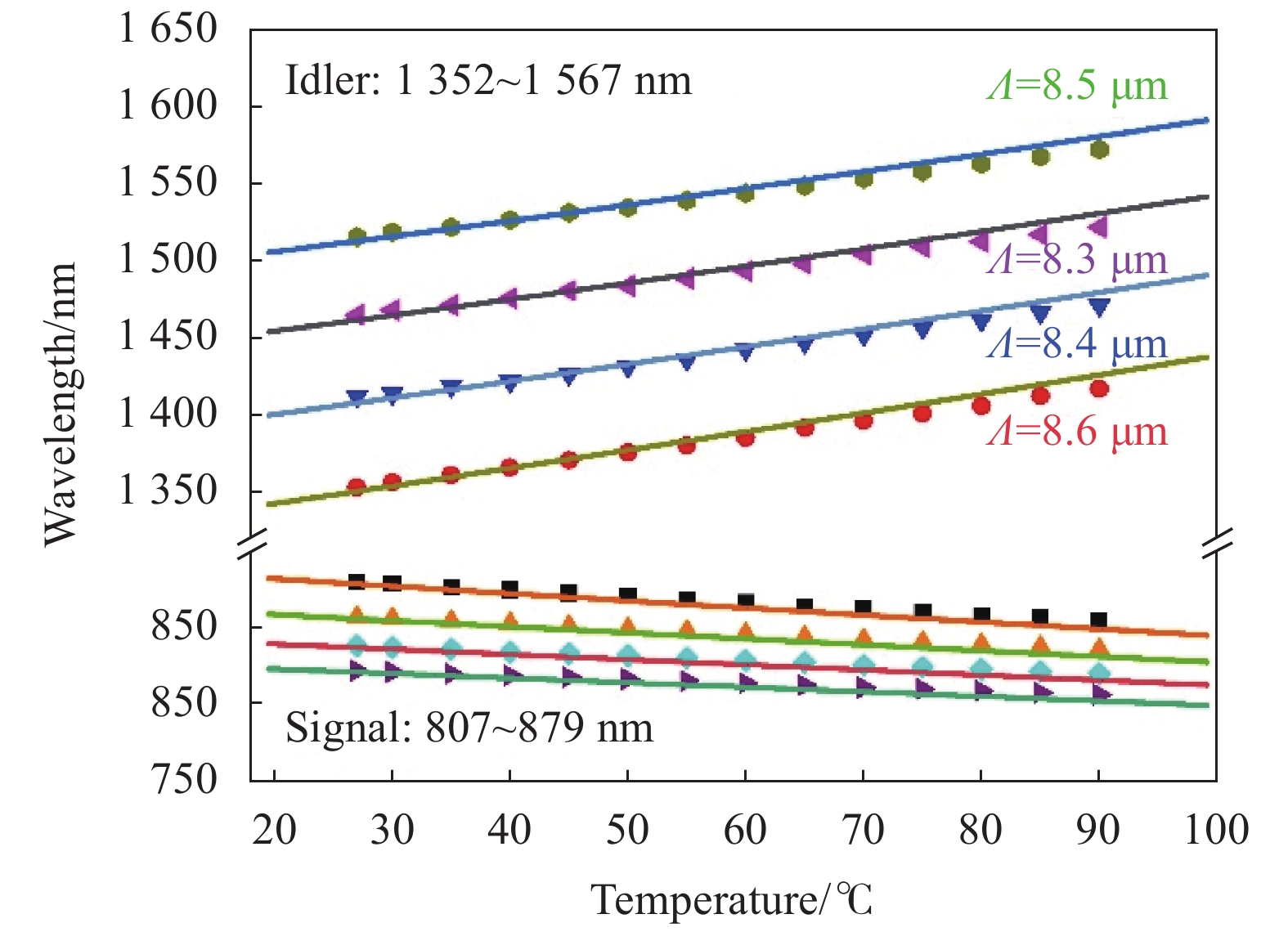-
基于准相位匹配技术的光学参量振荡器(OPO)是实现激光波长的调谐与拓展的有效途径之一。通过改变周期极化晶体的极化周期与温度等参数,可以得到覆盖可见光到中红外波段的可调谐激光输出,满足人们不同的使用需求[1-6]。与脉冲泵浦OPO相比,连续波(CW)OPO的增益低、阈值高,对非线性晶体的要求更高,实现起来更加困难。2008年,姚建铨院士课题组实现了由二极管端面抽运的Nd:YVO4激光器泵浦周期极化铌酸锂(PPLN)的连续波中红外腔内单谐振光参量振荡器(ICSRO),温度为140 ℃时,在3.86 μm处获得了155 mW的闲频光输出功率,光-光转换效率为1.82 %[7]。2009年,他们在1500 nm处获得820 mW的信号光输出功率,光-光转换效率为7.51 %[8]。2013年,他们采用880 nm激光二极管共振泵浦连续波ICSRO,在21.9 W泵浦功率下,获得了1.54 W的3.66 μm中红外闲频光输出,光-光转换效率为7.0%。通过升高输出镜对振荡光的透射率优化SRO阈值,在21.4 W泵浦功率下同时获得1.54 W的闲频光和5.03 W的信号光输出,总提取效率达到30.2%[9]。2020年,他们报道了一种全光纤结构的CW OPO,当泵浦功率为2 W时获得了0.5 W的1642.5 nm激光输出,实现了1642.5~1655.4 nm范围内的可调谐输出[10]。2021年,祝世宁院士团队采用ICSRO结构,808 nm半导体激光器泵浦Nd:YVO4晶体,PPLN晶体作为准相位匹配晶体,实现了2.25~4.79 μm中红外波段的可调谐输出,泵浦功率为9.1 W时,在3.189 μm处获得最大1.08 W的激光输出,转换效率为11.88%[11]。
周期极化钽酸锂(PPLT)晶体比PPLN晶体有更高的抗光损伤阈值,在短波近红外激光领域有强大的发展潜力。通过在PPSLT中掺杂MgO(MgO:sPPLT),可以有效降低晶体因可见光辐射导致的光折变损伤[12]。2007年,Samanta等人[13]采用环形腔的设计,利用532 nm的激光泵浦MgO:sPPLT,获得了1.59 W的单频、连续波近红外闲频光输出。2011年,Kumar等人[14]利用1064 nm的光纤激光器泵浦CW MgO:sPPLT-OPO,获得了高达5.5 W的中红外激光输出。2017年,Devi等人[15]利用532 nm连续波单频激光器泵浦扇形MgO:sPPLT晶体,在室温下获得了百毫瓦级的闲频光输出。国内对连续波OPO的研究相对较少,对短波近红外波段连续波MgO:sPPLT-OPO的报道较为少见。
文中采用连续波532 nm绿光激光器泵浦多周期MgO:sPPLT晶体,实现了连续波运转的高效率MgO:sPPLT-OPO。通过周期调谐和温度调谐相结合,获得了信号光807~879 nm和闲频光1352~1567 nm波段范围内无跳模的连续可调谐输出。在信号光821 nm处,最高输出功率达到6.8 W;当泵浦功率为5.4 W时,获得3.1 W输出,光-光转换效率达到57.4%。
-
实验装置如图1所示。实验采用的泵浦源为IPG Photonics 公司生产的GLR-20型连续波激光器,其中心波长为532 nm,最高输出功率达到20 W。OPO结构采用外腔式设计,532 nm泵浦光通过光隔离器后,经过焦距为100 mm的聚焦透镜将光斑压缩后耦合进入OPO系统。准相位匹配晶体是由日本OXIDE公司提供的MgO:sPPLT晶体,晶体尺寸为30 mm×15 mm×0.5 mm,掺杂了1%原子分数的MgO。晶体表面镀有532 nm的增透膜,极化周期为7.9~8.8 μm,共有10个极化周期。谐振腔采用闲频光单谐振(SRO)的双凹腔线性结构。谐振腔由两个平凹镜M1和M2组成,其曲率半径均为50 mm。输入镜M1的平面镀有对0.5~0.9 μm波段增透膜(R<0.6%),凹面则镀有对闲频光1.3~1.5 μm波段的高反(R>99.7%),532 nm高透(T>99.9%),和对0.5~0.9 μm波段高透(T>95%)的多层介质膜。输出镜M2的镀膜参数与输入镜M1相同。
基于对称双凹腔设计,在实验过程中MgO:sPPLT晶体被放置于谐振腔内的中心位置。将MgO:sPPLT晶体用铟箔包裹后放置于温控炉中,然后将温控炉固定在位移平台上,通过移动晶体的位置实现周期调谐,通过改变晶体的温度实现温度调谐,进而实现光学参量振荡器的连续可调谐无跳模输出。实验中,通过M3镜滤除多余的泵浦光,通过M4镜对闲频光进行过滤,得到信号光的输出特性。M3镜对0.8~1.6 μm波段的透过率>80%,M4镜对闲频光波段的反射率>99%。利用Ocean Optics公司生产的NIRQUEST512型近红外光谱仪及HR4000型光纤光谱仪同时检测输出的信号光及闲频光光谱。利用OPHIR公司生产的10A-PPS型功率计测量信号光输出功率。
-
在谐振腔中心位置处,通过激光光束轮廓仪(NanoScan V2,Ophir Photonics)测得经透镜聚焦后的泵浦光束腰直径约为100 μm,如图2所示。为满足模式匹配要求,结合对称双凹腔的特性和谐振腔稳态条件,设计谐振腔长为97 mm,此时谐振腔振荡光在谐振腔中的束腰直径约为96 μm,谐振腔内泵浦光与振荡光束腰比值接近1∶1。实验同时另外设计了腔长约为60 mm和80 mm的两种谐振腔,谐振腔内泵浦光束腰与振荡光束腰比值分别为1∶2.3和1∶1.8。在8.6 μm极化周期和晶体温度为27 ℃条件下,得到了这三种谐振腔的信号光功率随泵浦光功率的变化关系,如图3所示。60 mm腔长的谐振腔振荡阈值最低约为1.45 W,这是因为更小的泵浦光斑提供了更高的功率密度。97 mm腔长的谐振腔振荡阈值最高约为3.0 W,但在9 W泵浦功率下其信号光输出功率却为最高约4.8 W,相对更大的振荡光模式体积对这一现象的产生有直接影响。这些结果表明模式匹配对高功率输出有较大影响,以下工作均围绕97 mm谐振腔进行研究分析。

Figure 3. Signal output power as function of the pump power with different kinds of laser cavity lengths at 27 ℃
由于谐振腔镜对闲频光1.3~1.5 μm波段的反射率>99.7%,实验中只检测到微弱的闲频光信号,因此文中只对信号光特性进行重点分析。图4所示为晶体温度为27 ℃,泵浦功率为13.6W时,821、837、856、879 nm的信号光分别对应的最大输出功率。同时对这4个波长的输出功率随泵浦功率变化的特性分别进行了研究,实验结果如图5所示。随着泵浦功率的增加,信号光的输出功率也在逐渐增加。当输入泵浦功率达到13.6 W时,在821 nm处,获得了6.8 W的输出,光-光转换效率达到50.0%。而当泵浦功率为5.4 W时,获得了3.1 W的821 nm激光输出,光-光转换效率达到了57.4%。极化周期为8.3、8.4、8.5 μm时,在同样泵浦功率下,分别得到了48.2%、51.7%及55.2%的高转换效率。在泵浦功率13.6 W时,在879、856、837 nm波段处获得的输出功率分别达到5.9、6.2、6.4 W,对应的光-光转换效率分别达到43.4%、45.6%和47.1%。图5(b)所示为为在0~13.6 W的泵浦功率范围内,821、837、856、879 nm波长对应的最高光-光转换效率分别为57.4%、55.2%、51.7%和48.2%。从图中可以看出,在4个波长均在泵浦功率在6 W附近时,光-光转换效率达到峰值,随着泵浦功率的进一步增加,转换效率逐渐下降,但是,OPO系统的输出仍保持着43%以上的高转换效率。随着泵浦功率的逐渐增加,输出功率也保持上升趋势,而且没有出现饱和的迹象。分析认为高转换效率的实现与单谐振结构和闲频光的高反射率有一定的关系,不过出于预防晶体损伤等原因的考虑,实验没有进一步增加泵浦功率。
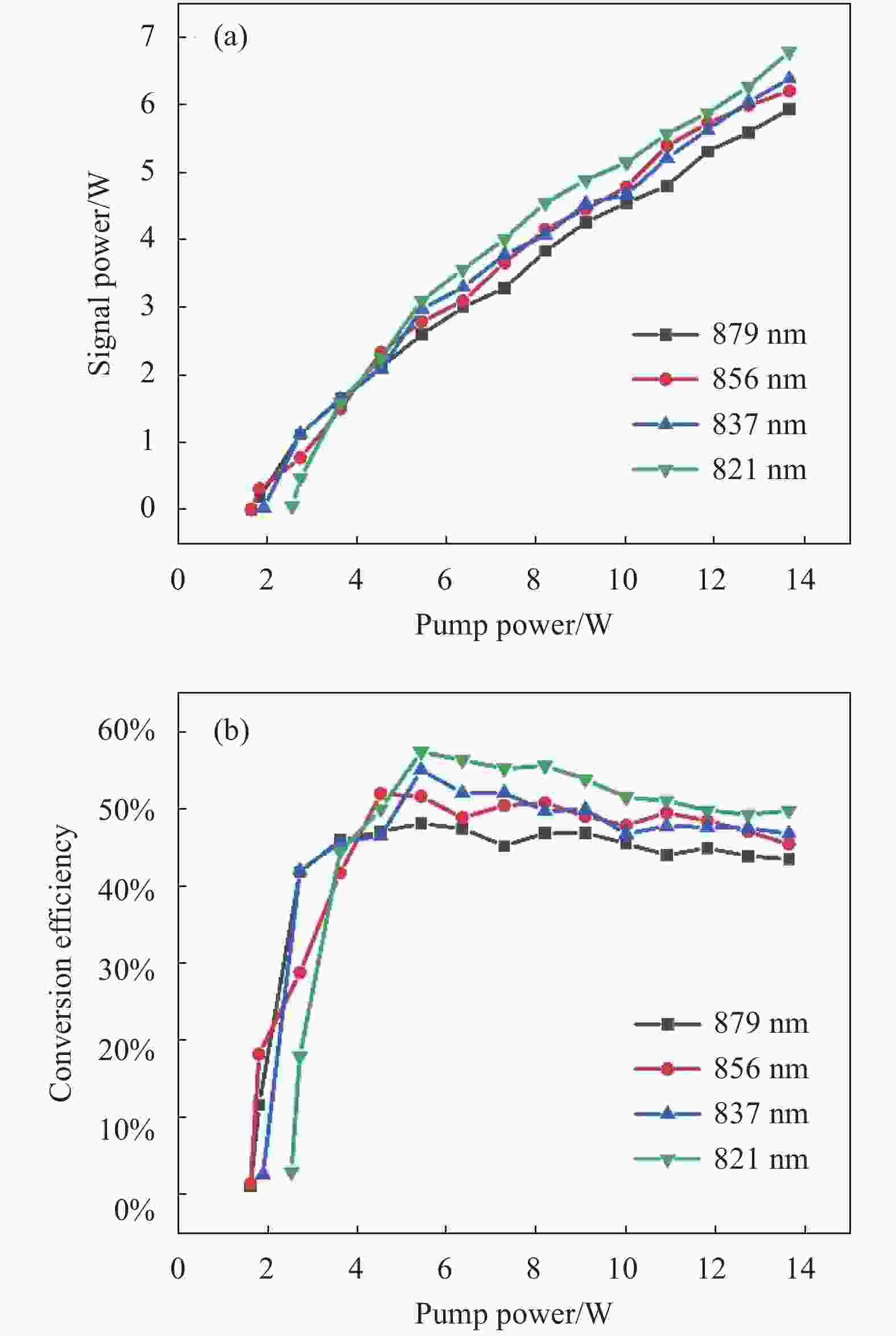
Figure 5. Signal output power and conversion efficiency as functions with pump power when the poling periods are 8.3, 8.4, 8.5 and 8.6 μm at 27 ℃. (a) Signal output power; (b) Conversion efficiency
通过温控炉将晶体温度控制在27 ℃,移动位移平台,得到了8.3、8.4、8.5、8.6 μm 4个极化周期的周期调谐光谱曲线,分别是879、856、837、821 nm信号光及其相对应的1 352、1 411、1 464、1 515 nm闲频光,如图6所示。
如图7所示,将实验结果与根据Sellmeier色散方程[16]计算得到的理论值进行对比,图中的实线为理论计算值曲线,离散点为实验测量值。从图7中可以看出,在信号光波段,实验值与理论值高度符合,在闲频光波段,实验结果与理论值也保持较高的重合性,因此Sellmeier色散方程对工作温度为27 ℃的周期调谐具有较高的参考价值。
在周期调谐的基础上,通过改变MgO:sPPLT晶体的温度获得了8.3、8.4、8.5、8.6 μm 4个周期的温度调谐曲线,如图8所示。图中离散点为实验测量得到的输出光谱数据,实线为根据Sellmeier色散方程得到的理论值。通过对比发现,在27~83 ℃范围内改变这4个极化周期的温度就可以实现807~879 nm信号光和1352~1567 nm闲频光波段范围内不间断地连续可调谐输出,实验结果与理论值在低温条件下(27~50 ℃)比较吻合,而在高温条件下(55~90 ℃)实验结果与理论值有一定偏差,分析认为这是由于所采用的Sellmeier色散方程在高温条件下的精度有限所导致。根据温度调谐的结果发现周期不同,温度调谐速度也略有不同,随着极化周期的增加调谐速度逐渐降低,信号光和闲频光的变化趋势相同,如图9所示。8.3 μm周期的信号光调谐速度约为−0.4 nm/℃,闲频光调谐速度约为1.0 nm/℃,而8.6 μm周期的信号光调谐速度则降至−0.25 nm/℃,闲频光调谐速度则降至0.9 nm/℃。

Figure 8. Signal and idler wavelength tuning varies with temperature when the grating periods are 8.3, 8.4, 8.5 and 8.6 μm

Figure 9. Temperature tuning rates of signal and idler spectra at poling periods of 8.3, 8.4, 8.5 and 8.6 μm
当泵浦功率为5.4 W时,在距离OPO输出腔镜M2约150 mm处,利用光束轮廓仪测试了信号光光斑的轮廓,获得的光斑强度分布图像如表1所示。从测试结果可以看出,不同信号光在X和Y方向的光斑大小均接近1∶1,且都表现为近高斯分布。
Grating period 8.3 μm
X:2.3 mm
Y:2.4 mm8.4 μm
X:2.3 mm
Y:2.6 mm8.5 μm
X:2.4 mm
Y:2.6 mm8.6 μm
X:2.4 mm
Y:2.5 mm



Table 1. Signal beam profile of different periods
-
实验采用准相位匹配MgO:sPPLT晶体,用532 nm连续波激光器作为泵浦源,通过外腔、单谐振的结构设计,实现了连续波高转换效率的宽波段可调谐光学参量振荡。实验研究了MgO:sPPLT-OPO的周期调谐和温度调谐特性,对比了信号光输出功率随泵浦功率的变化。实验通过对8.3、8.4、8.5、8.6 μm4个周期进行周期调谐获得了信号光821~879 nm和闲频光1352~1515 nm波段的可调谐激光输出。在周期调谐的基础上,结合温度调谐,实现了807~879 nm信号光和1352~1567 nm闲频光波段范围内不间断地连续可调谐输出,调谐速度随着周期的增加而逐渐降低。在信号光中心波长为821 nm处,当泵浦功率为5.4 W时,最高转换效率达到了57.4%;当泵浦功率为13.6 W时,在821 nm处的最大输出功率达到6.8 W。821、837、856、879 nm波长对应的最高光-光转换效率分别为57.4%、55.2%、51.7%和48.2%,且输出光光斑均呈近高斯分布。
High-conversion-efficiency continuous-wave near-infrared singly resonant optical parametric oscillator
doi: 10.3788/IRLA20210654
- Received Date: 2022-01-10
- Rev Recd Date: 2022-02-25
- Publish Date: 2022-08-05
-
Key words:
- optical parametric oscillator /
- MgO:sPPLT crystal /
- near-infrared laser /
- continuous-wave
Abstract: High-power, high-conversion-efficiency and tunable continuous-wave (CW) near-infrared external-cavity pumped singly resonant optical parametric oscillator (SRO) was proposed. OPO based on a quasi-phase-matched (QPM) nonlinear crystal was a very effective technology to obtain the short-wave near-infrared tunable laser sources. CW laser at 532 nm was used as the fundamental laser source to drive the OPO in the cavity. The QPM crystal was a multi-grating MgO-doped stoichiometric periodically poled LiTaO3(MgO:sPPLT). The widely tunable SRO output signal wavelength ranging from 807 to 879 nm and idler wavelength ranging from 1352 to 1567 nm were achieved by combination of poling period tuning and temperature tuning with four different periodically poled gratings from 8.3 to 8.6 μm. By means of using single resonant of idler light, the output power of the signal (821 nm) was 3.1 W at a pump power of 5.4 W with the efficiency of 57.4% was achieved. Under an incident pump power of 13.6 W, a maximum signal output power of 6.8 W at 821 nm was obtained with the period of 8.6 μm.



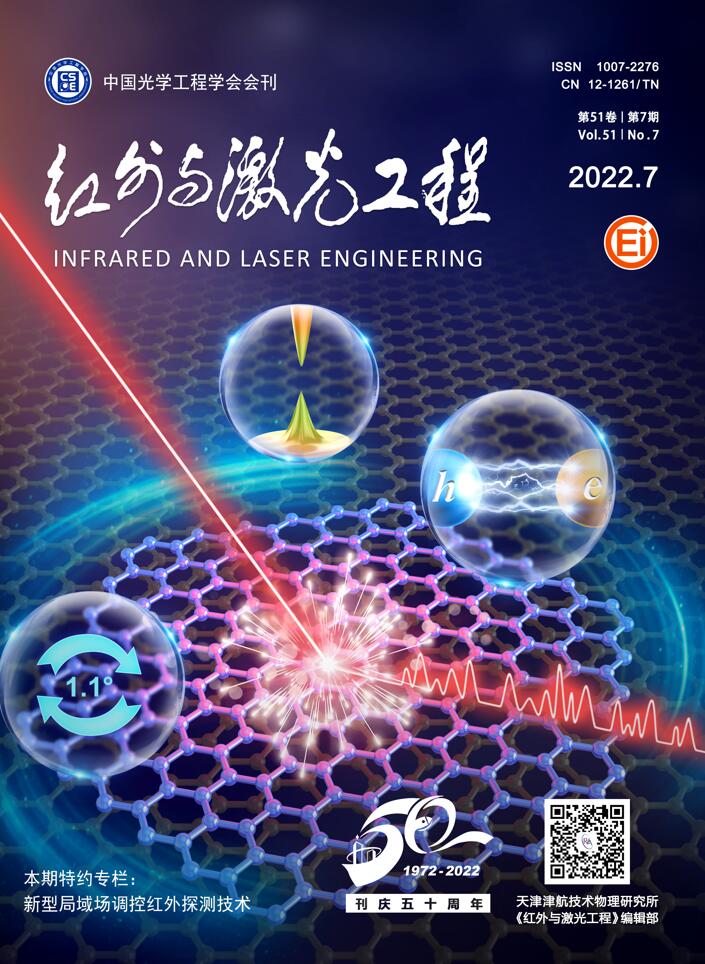







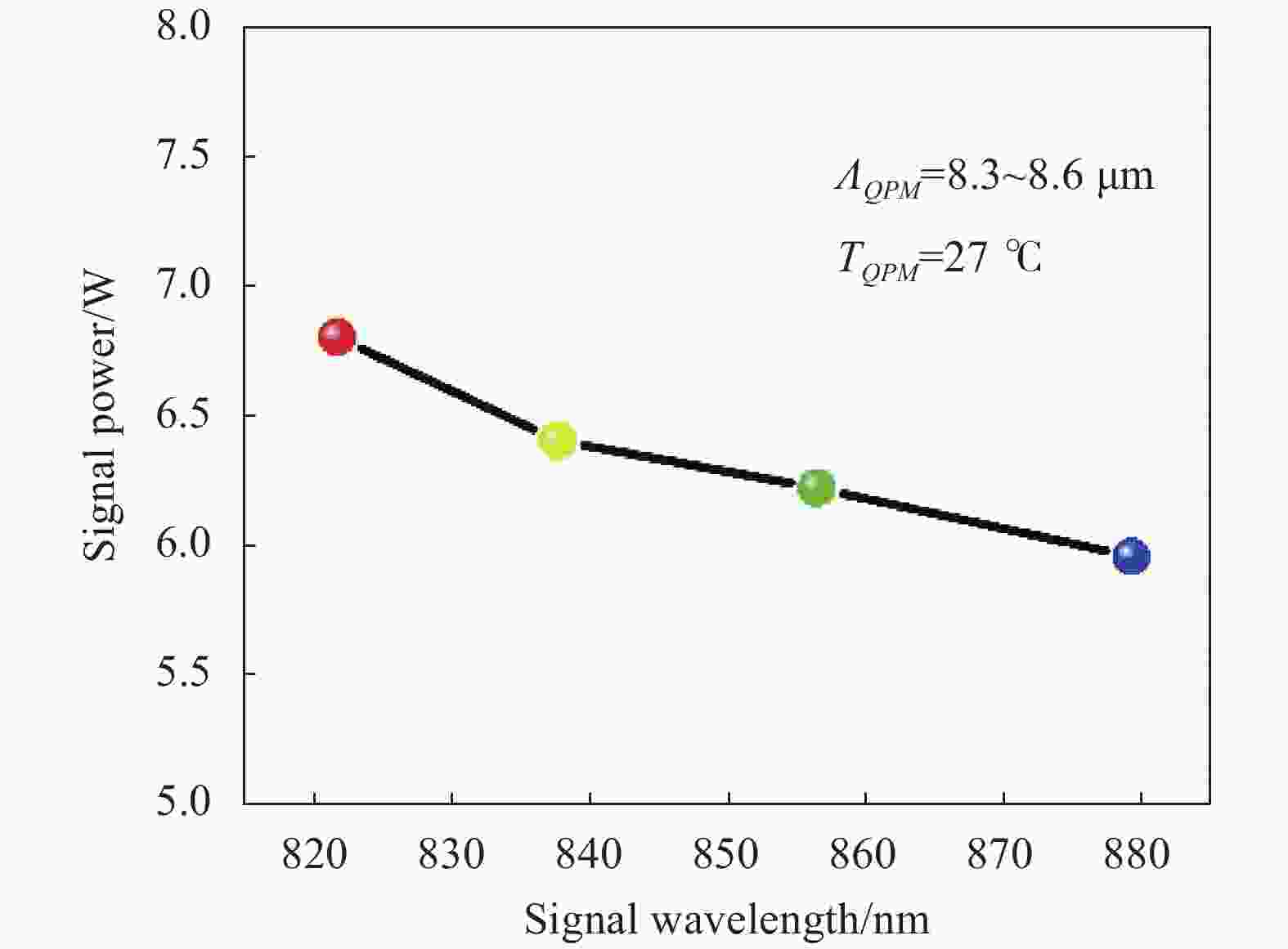
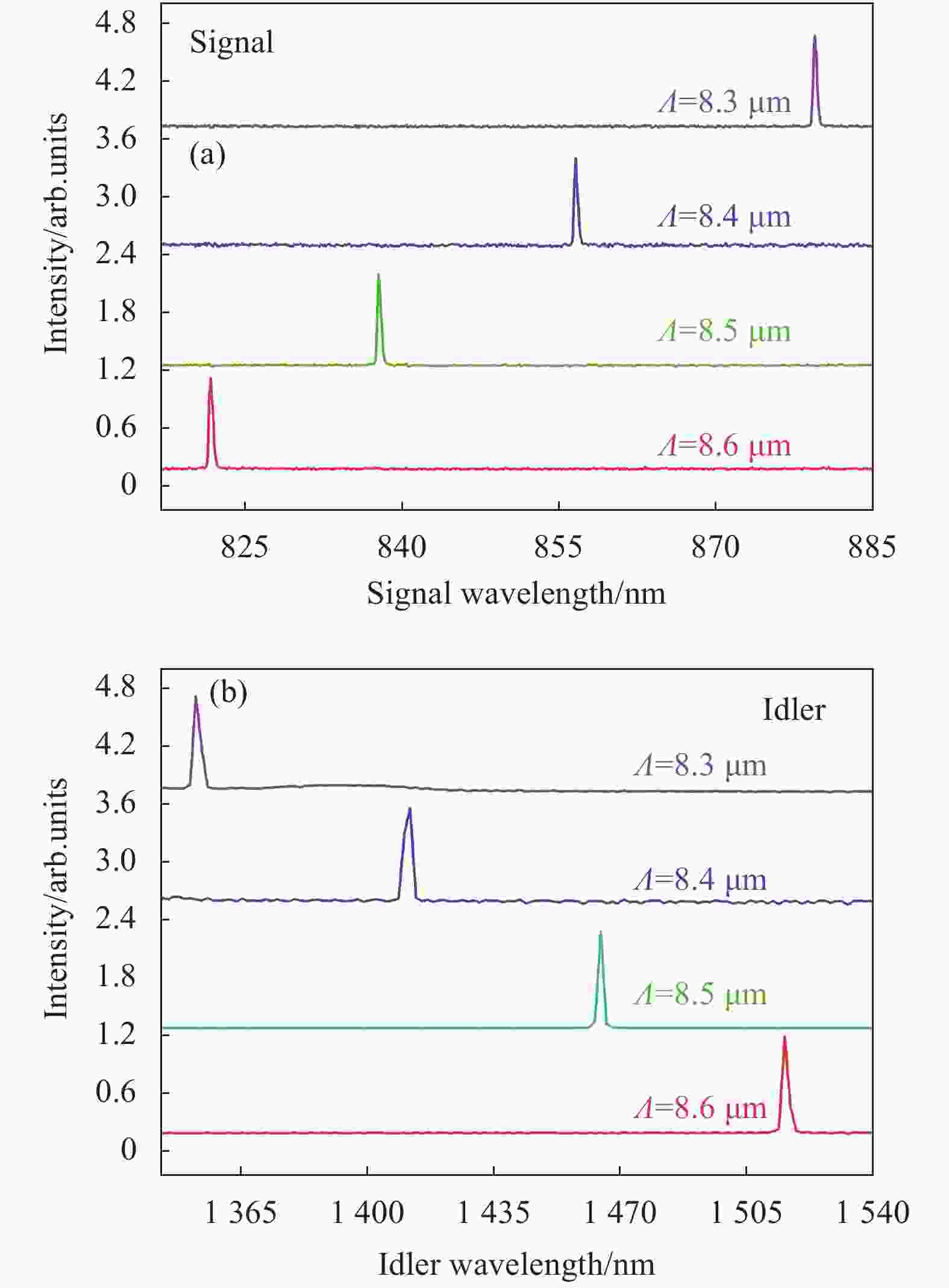


 DownLoad:
DownLoad:

